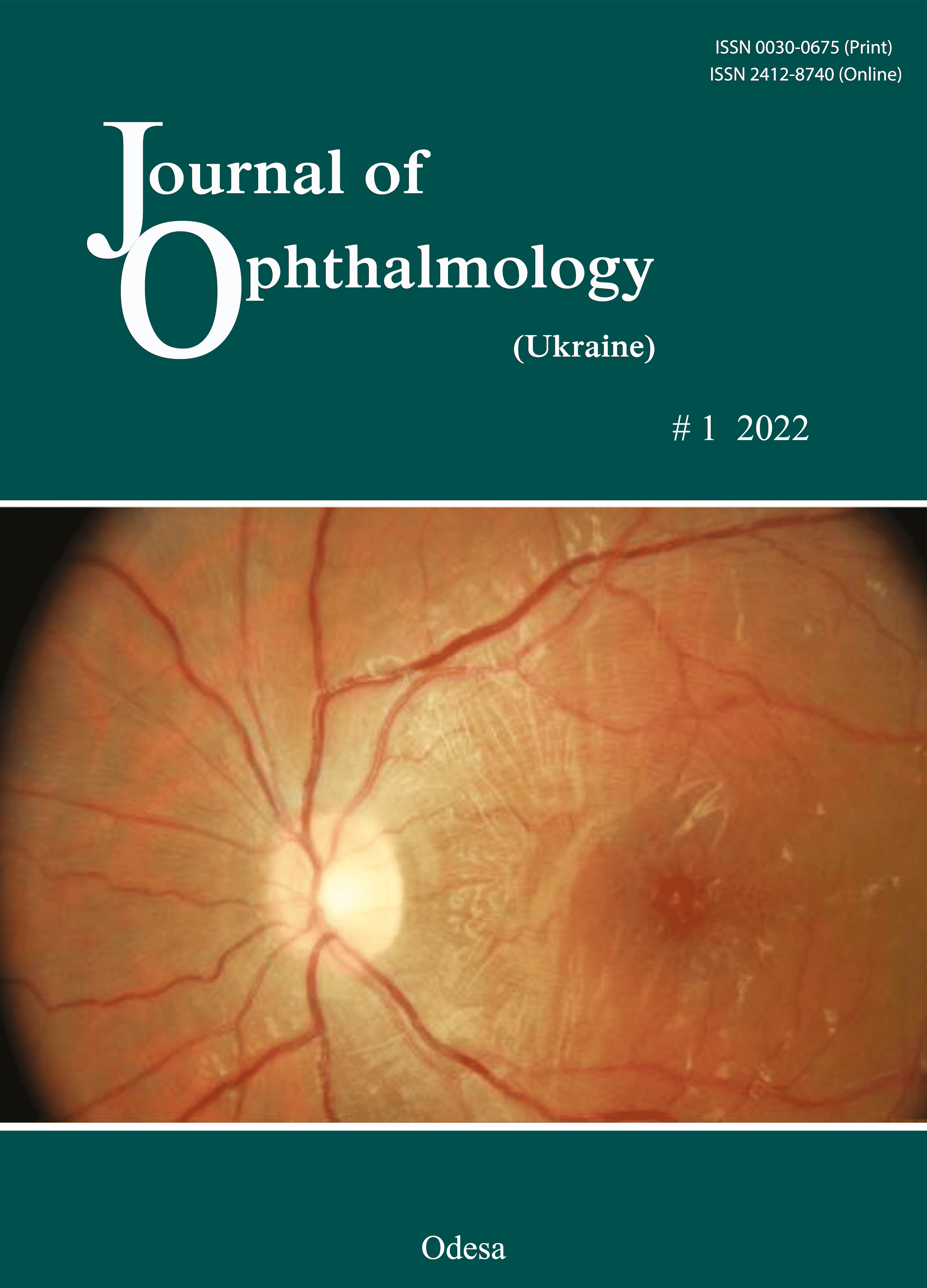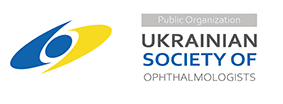Assessing the efficacy of various treatment regimens for patients with endocrine ophthalmopathy associated with Graves’ disease
DOI:
https://doi.org/10.31288/oftalmolzh202215157Keywords:
Graves’ disease, endocrine ophthalmopathy, TSHR-Ab, glucocorticoid pulse therapy, thyroidectomy, ultrasound imagingAbstract
Purpose: To assess the efficacy of various treatment regimens for patients with EO associated with Graves’ disease based on the retrospective analysis of clinical data, thyroid-stimulating hormone (TSH) receptor autoantibodies (TSHR-Ab) titers and orbital ultrasound imaging findings.
Material and Methods: We retrospectively reviewed the medical records (including clinical and laboratory data and findings of ultrasound imaging of retrobulbar adipose tissue) of 155 patients with EO associated with Graves’ disease and either euthyroidism (in the presence of antithyroid therapy) or postoperative compensated hypothyroidism that underwent treatment at Komisarenko Institute for Endocrinology and Metabolism between 2009 and 2019. The duration of EO ranged from 8 months to 36 months. Patients with EO associated with Graves’ disease were medically treated in the presence of stable euthyroidism. Patients were divided into 4 groups based on the glucocorticoid treatment scheme. Group 1 of 15 patients received prednisolone tablets per os; group 2 of 68 patients, intravenous methylprednisolone (MP) pulse therapy only; group 3 of 32 patients, intravenous MP pulse therapy plus vitamin D3; and group 4 of 40 patients, intravenous MP pulse therapy 8 to 12 months after thyroidectomy.
Results: As soon as 3 months after treatment initiation, there was an improvement in condition of patients in all groups as assessed by clinical examination, followed by further improvement by 6 months and 12 months. The best results were obtained in patients of group 4, with a statistically significant improvement in clinical condition (p < 0.05). Retrobulbar adipose tissue thickness as assessed by orbital ultrasound at baseline and at 6 months and 12 months was statistically significantly greater in patients of all the four groups than controls (p < 0.05). At 6 months, serum TSHR-Ab levels in groups 1, 2 and 3 significantly decreased compared to baseline, with no significant difference between these groups, whereas serum TSHR-Ab level in group 4 was significantly higher than in other groups both at baseline and at 6 months. At 12 months, serum TSHR-Ab level in group 4 was significantly lower (р < 0.05) than in other groups (2.41 ± 0.81 mU/L versus 5.97 ± 1.71 mU/L for group 1, 5.49 ± 1.27 mU/L for group 2, and 6.17 ± 1.18 mU/L for group 3).
Conclusion: Patients with EO associated with Graves’ disease in group 4 (intravenous MP pulse therapy after thyroidectomy) showed a significantly better (р < 0.05) treatment outcome than patients in other groups. Ultrasound imaging of retrobulbar adipose tissue thickness is inadequately informative for assessing treatment efficacy.
References
1.Taskina ES, Charinzeva SV, Charinzev VV, Serkin DM. [New opportunities in endocrine ophthalmopathy diagnostics (review)]. Klinicheskaya i eksperimental'naya tireoidologiya. 2017;13(3):20-28. Russian. https://doi.org/10.14341/ket2017320-28
2.Taylor PN, Zhang L, Lee RWJ, Muller I, Ezra DG, Dayan CM, et al. New insights into the pathogenesis and nonsurgical management of Graves' orbitopathy. Nat Rev Endocrinol. 2020 Feb;16(2):104-16. https://doi.org/10.1038/s41574-019-0305-4
3.Weiler DL. Thyroid eye disease: a review. Clin Exp Optom. 2017 Jan;100(1):20-25. https://doi.org/10.1111/cxo.12472
4.Khong JJ, McNab AA, Ebeling PR, Craig JE, Selva D. Pathogenesis of thyroid eye disease: review and update on molecular mechanisms. Br J Ophthalmol. 2016 Jan;100(1):142-50. https://doi.org/10.1136/bjophthalmol-2015-307399
5.Dedov II, Melnichenko GA, Sviridenko NYu, Troshina EA, Fadeev VV, Belovalova IM, et al. [Federal clinical recommendations on diagnostics and treatment of endocrine ophthalmopathy associated with autoimmune thyroid pathology]. Problemy Endokrinologii. 2015;61(1):61-74. Russian. https://doi.org/10.14341/probl201561161-74
6.Bartalena L, Piantanida E, Gallo D, Lai A, Tanda ML. Epidemiology, natural history, risk factors, and prevention of Graves' orbitopathy. Front Endocrinol (Lausanne). 2020 Nov 30;11:615993. https://doi.org/10.3389/fendo.2020.615993
7.Kahaly GJ. Immunotherapies for thyroid eye disease. Curr Opin Endocrinol Diabetes Obes. 2019 Oct;26(5):250-5. https://doi.org/10.1097/MED.0000000000000493
8.Olyinyk VA, Terekhovа GM, Buldygina YuV, Fed'ko TV, Klochkova VM, Rakov OV, Lysova ZG. Treatment of autoimmune ophthalmopathy in patients with diffuse toxic goiter by glucocorticoids. Endokrynolohiya. 2017; 22(2):108-14.
9.Novaes P, Diniz Grisolia AB, Smith TJ. Update on thyroid-associated Ophthalmopathy with a special emphasis on the ocular surface. Clin Diabetes Endocrinol. 2016 Nov 16;2:19. https://doi.org/10.1186/s40842-016-0037-5
10.Edmunds MR, Boelaert K. Knowledge of thyroid eye disease in Graves' disease patients with and without orbitopathy. Thyroid. 2019 Apr;29(4):557-62. https://doi.org/10.1089/thy.2018.0665
11.Perros P, Hegedüs L, Bartalena L, Marcocci C, Kahaly GJ, Baldeschi L, et al. Graves' orbitopathy as a rare disease in Europe: a European Group on Graves' Orbitopathy (EUGOGO) position statement. Orphanet J Rare Dis. 2017 Apr 20;12(1):72. https://doi.org/10.1186/s13023-017-0625-1
12.Bartalena L, Baldeschi L, Boboridis K, Eckstein A, Kahaly GJ, Marcocci C, et al; European Groupon Graves' Orbitopathy (EUGOGO). The 2016 European Thyroid Association/European Group on Graves' Orbitopathy Guidelines for the Management of Graves' Orbitopathy. Eur Thyroid J. 2016 Mar;5(1):9-26. https://doi.org/10.1159/000443828
13.Pashkovska NV. [Endocrine ophthalmopathy in autoimmune diseases of the thyroid gland]. Mizhnarodnyi endokrynolohichnyi zhurnal. 2014;6 (62): 169-73.
14.Lanzolla G, Vannucchi G, Ionni I, Campi I, Sileo F, Lazzaroni E, Marinò M. Cholesterol serum levels and use of statins in Graves' orbitopathy: a new starting point for the therapy. Front Endocrinol (Lausanne). 2020 Jan 22;10:933. https://doi.org/10.3389/fendo.2019.00933
15.Perros P, Dayan CM, Dickinson AJ, Ezra D, Estcourt S, Foley P, et al. Management of patients with Graves' orbitopathy: initial assessment, management outside specialised centers and referral pathways. Clin Med (Lond). 2015 Apr;15(2):173-8. https://doi.org/10.7861/clinmedicine.15-2-173
16.Strianese D. Efficacy and safety of immunosuppressive agents for thyroid eye disease. Ophthalmic Plast Reconstr Surg. 2018 Jul/Aug;34(4S Suppl 1):S56-S59. https://doi.org/10.1097/IOP.0000000000001131
17.Hales IB, Thoma ID. Treatment of thyroid ophthalmopathy with corticoid analogues. Australas Ann Med. 1962 May;11:113-7. https://doi.org/10.1111/imj.1962.11.2.113
18.Hodgson NM, Rajaii F. Current understanding of the progression and management of thyroid associated orbitopathy: a systematic review. Ophthalmol Ther. 2020 Mar;9(1):21-33. https://doi.org/10.1007/s40123-019-00226-9
19.Stan MN, Salvi M. Management of endocrine disease: Rituximab therapy for Graves' orbitopathy-lessons from randomized control trials. Eur J Endocrinol. 2017 Feb;176(2):R101-R109. https://doi.org/10.1530/EJE-16-0552
20.Salvi M, Vannucchi G, Currò N, Campi I, Covelli D, Dazzi D, et al. Efficacy of B-cell targeted therapy with rituximab in patients with active moderate to severe Graves' orbitopathy: a randomized controlled study. J Clin Endocrinol Metab. 2015 Feb;100(2):422-31. https://doi.org/10.1210/jc.2014-3014
21.Moleti M, Giuffrida G, Sturniolo G, Squadrito G, Campennì A, Morelli S, et al. Acute liver damage following intravenous glucocorticoid treatment for Graves' ophthalmopathy. Endocrine. 2016 Oct;54(1):259-68. https://doi.org/10.1007/s12020-016-0928-3
22.Nikonova LV, Tishkovskiy SV, Hadomskaya VI, Davydchyk EV, Doroshkevich IP. [Modern approaches to the therapy of endocrine ophthalmopathy]. Zhurnal Grodnenskogo meditsinskogo universiteta. 17(1):83-1. Russian. http://journal-grsmu.by/index.php/ojs/article/view/2371.
23.Riedl M, Kolbe E, Kampmann E, Krämer I, Kahaly GJ. Prospectively recorded and MedDRA-coded safety data of intravenous methylprednisolone therapy in Graves' orbitopathy. J Endocrinol Invest. 2015 Feb;38(2):177-82. https://doi.org/10.1007/s40618-014-0227-x
24.Covelli D, Vannucchi G, Campi I, Currò N, D'Ambrosio R, Maggioni M, Gianelli U, Beck-Peccoz P, Salvi M. Statins may increase the risk of liver dysfunction in patients treated with steroids for active graves' orbitopathy. J Clin Endocrinol Metab. 2015 May;100(5):1731-7. https://doi.org/10.1210/jc.2014-4463
25.Zoubek ME, Pinazo-Bandera J, Ortega-Alonso A, Hernández N, Crespo J, Contreras F, et al. Liver injury after methylprednisolone pulses: A disputable cause of hepatotoxicity. A case series and literature review. United European Gastroenterol J. 2019 Jul;7(6):825-837. https://doi.org/10.1177/2050640619840147
26.Kahaly GJ. Imaging in thyroid-associated orbitopathy. Eur J Endocrinol. 2001 Aug;145(2):107-18. https://doi.org/10.1530/eje.0.1450107
27.Yanik B, Conkbayir I, Acaroglu G, Hekimoglu B. Graves' ophthalmopathy: comparison of the Doppler sonography parameters with the clinical activity score. J Clin Ultrasound. 2005 Oct;33(8):375-80. https://doi.org/10.1002/jcu.20154
28.Nagy EV, Toth J, Kaldi I, Damjanovich J, Mezosi E, Lenkey A, et al. Graves' ophthalmopathy: eye muscle involvement in patients with diplopia. Eur J Endocrinol. 2000 Jun;142(6):591-7. https://doi.org/10.1530/eje.0.1420591
29.Marcocci C, Bartalena L, Tanda ML, Manetti L, Dell'Unto E, Rocchi R, et al. Comparison of the effectiveness and tolerability of intravenous or oral glucocorticoids associated with orbital radiotherapy in the management of severe Graves' ophthalmopathy: results of a prospective, single-blind, randomized study. J Clin Endocrinol Metab. 2001 Aug;86(8):3562-7. https://doi.org/10.1210/jcem.86.8.7737
30.Buldygina YuV, Terekhova GM, Shlachtych SL, Fed'koTV, Klochkova VM, Strafun OS. [The results of surgical treatment of patients with diffuse toxic goiter and autoimmune ophthalmopathy]. Endokrynolohiya. 25(1): 5-10. Ukrainian. https://doi.org/10.31793/1680-1466.2020.25-1.5
Downloads
Published
How to Cite
Issue
Section
License
Copyright (c) 2025 Ю. В. Булдигіна, Г. М. Терехова, Л. С. Страфун, І. І. Савосько, З. Г. Лисова, С. Л. Шляхтич

This work is licensed under a Creative Commons Attribution 4.0 International License.
This work is licensed under a Creative Commons Attribution 4.0 International (CC BY 4.0) that allows users to read, download, copy, distribute, print, search, or link to the full texts of the articles, or use them for any other lawful purpose, without asking prior permission from the publisher or the author as long as they cite the source.
COPYRIGHT NOTICE
Authors who publish in this journal agree to the following terms:
- Authors hold copyright immediately after publication of their works and retain publishing rights without any restrictions.
- The copyright commencement date complies the publication date of the issue, where the article is included in.
DEPOSIT POLICY
- Authors are permitted and encouraged to post their work online (e.g., in institutional repositories or on their website) during the editorial process, as it can lead to productive exchanges, as well as earlier and greater citation of published work.
- Authors are able to enter into separate, additional contractual arrangements for the non-exclusive distribution of the journal's published version of the work with an acknowledgement of its initial publication in this journal.
- Post-print (post-refereeing manuscript version) and publisher's PDF-version self-archiving is allowed.
- Archiving the pre-print (pre-refereeing manuscript version) not allowed.












